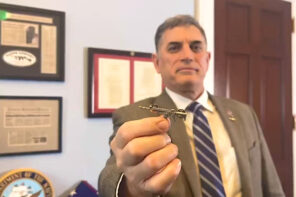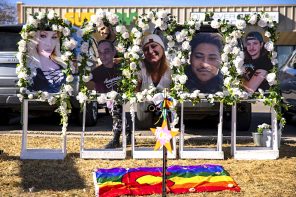Early Sunday morning I woke up, my phone abuzz with news. Reading about the shooting in Orlando, worry and fright overcame me. Still in a semi-wake, semi-sleep, semi-dream state, I thought it was Charleston all over again. Emanuel AME redux.
My partner saw my face and asked what had happened. We turned on the television to learn that a man named Omar Mateen had entered a popular gay nightclub on its “Latin Night.” Using an AR-15 assault rifle and a semi-automatic handgun for backup, and claiming allegiance to ISIS, Mateen unleashed his homophobic terror through the barrel of a gun.
I am grieving and mourning. As I wrote to a friend, “I’m just sick over this… Fighting depression over it all. . . They are us; we are them. No ‘they,’ No ‘us’. They and us, I and other, an/other I, an/other we, blur and fade. We through each other.”
I could not help but think about the stuff on black assembly I’m working on now—on blackness as an alternate imagination of communion, on communion otherwise. As I watched the endless loop of coverage and tracked my twitter feed, I thought about blackness as an alternative mode of congregationing, an alternate, ecumenical, non-exclusionary collectivity that exceeds black church, that ain’t reducible to black church, but that black church has a special relationship to.
Black church’s relationship to blackness—like black folks’s relationship to blackness—is one of bearing witness. It’s a relationship of testimony. Black church at its best testifies to emergent and non-exclusionary sociality, contact, and touch. Communal feeling, or feeling commune-ion, blackness is an alternate sanctum, an otherwise sanctuary, an ecology or constellation of joyous practices of re/assemblage-amid-disassemblage. Quantum communions, quantum solidarities.
Orlando’s Pulse is this too.
This is a moment for unequivocal black church and queer/ LGBT solidarity because antiblackness and homophobia and transphobia are interconnected. More still, in the face of Trump’s doubling down on anti-Muslim rhetoric in the wake of the shooting, it is a moment for a solidarity that refuses Islamophobia.
That is to say, Emanuel AME and Pulse, Charleston and Orlando, must be understood together. Both are expressions of what I call “dark church communions,” expressions of emergent collectivities, alternate modes of life together. Both are expressions of the alternative that already is, that already surrounds us as an/other practice of the political. It is this alternative that Roof was shooting at least year and Mateen took aim at this past weekend. Emanuel AME and Pulse are both experiments in what it means to live together. Emanations of sovereignty in a settler colonial society, Roof and Mateen targeted unsovereign or experimental sociality. They tried to kill the music, arrest the beat, stop the propulsive poetics of Emanuel’s Pulse:
Pulse / cardiovascular movement / on the dance floor / sacred spirit’s thumb and strum / now under cardiac / arrest’s / storm and stress / Pulse’s Emanuel / a metaphysical condition of holy ghostliness on the dance floor / feel the beat / breath’s percussive rhythm / pulsation’s respiration / its aspirational inhalation / its exasperational exhalation / Emanuel’s Pulse, a “pneumatic pact“
In Charleston and now Orlando, last year was this year’s future. Church and nightclub, sanctuaries of the Sacred, places for the celebration of (the) mass(es). Life’s (w)holiness, notwithstanding the bullet holes now in it.
With vigilance, hold vigil with me.
We know that neither Christianity nor Islam are reducible to the violence perpetrated in their names. Just as we didn’t reduce Christianity to Dylann Roof, it’s nothing but an expression of Islamophobia to reduce Islam to what Omar Mateen has done or the wake of carnage he’s left.
In a Facebook post, Emilie Townes said it well:
Radical hatred is no respector of religion or ideology. . . . Those of use who believe in justice must stand against [radical hatred] by working to pass sane gun laws, better [understand] how all of our religions can be turned toward hatred if we are not ever-vigilant. . .
Yes. And just as we must better understand how any religion can be turned toward and made to express hatred, so too we can and must give ourselves to turning our faith traditions against such hatred so that they may be vehicles of life and hope.
But what does this mean in the specific case of the black church, in relation to the LGBT community? In its black church expression, what does Christianity’s turn against religion-based hatred and against gun culture mean? In short, in the face of the largest mass killing in U.S. history perpetrated by a single person, what is to be done?
It means that black church must stand in unequivocal solidarity with those massacred at the Pulse nightclub and must hold vigil with LGBT persons. Such solidarity is the practice of hope, testimony to unkillable life together, a statement that the sacred experiment of our being together will not die, cannot die, will continue.
My Sunday morning semi-wake semi-sleep semi-dream state wherein last year’s Charleston shooting merged with this past weekend’s Orlando massacre was more than a dream. My dream condition/wake condition, my condition of being almost-sleep/almost-woke, spoke something true. It spoke a dream-reality of black church-LGBT solidarity in a shared relation, a genesis shared. This condition awakened me to a dream already testified to: Charleston and Orlando, Emanuel and Pulse, togetherness known through each other.
To black Christians I say: you can’t be (rightly) against what happened in Charleston at Emanuel AME and indifferent, quiet or not equally outraged about what happened in Orlando at the Pulse nightclub on “Latin night.” Both are sanctuaries. The communion is ecumenical. It is shared. Emanuel and Pulse. Both are temples violently invaded, subjected to assaults on a sociality that calls out to us all and is sent to us all and that sends us all into the mission or infinite rehearsal of deregulated social life of sacred/joyous getting together.
In other words, if Emanuel and Pulse are to be understood together, as I state here that they must, this means that we must understand the weekend’s massacre as a species of antiblackness. It was an attack on us all, for blackness is beautifully queer and queerness is beautifully churchical, beautifully ecumenical. Black church is nothing less than the practice and celebration of such queerness, of such strangely beautiful social life together.
Black church is nothing less than the study—and therefore the practice and celebration—of emergent, experimental, expansive, ecumenical, unfinished socialities. That is what black church is. That is Emanuel. And it is Pulse. It’s why one killer attacked Emanuel and another attacked Pulse. They jointly targeted Emanuel’s Pulse. They tried to stop the heartbeat, stay the hope, preempt the practice of emergent non-exclusionary life together, halt the “undercommons,” stop the vigils of “black gathering,” close down the “dark communions,” the “luminous darkness” of churchical blackness. They tried to silence the music, (cardiac)arrest the pulse, that queer heartbeat, the breath of life. They wanted to stop the rapturous dance on the dance floor, the celebrations on the church floor, spirit’s queer communions.
In the face of this what is to be done? Of course, we must continue to pressure legislators for sensible and sane gun laws, though as Eric Olson Ghetty remarked on my Facebook feed, “the gun control debate [may have] ended when we decided to do nothing after 27 white children were massacred at Sandy Hook.”
But beyond resignation, or rather in defiant testimony, we must assert as the old R&B hit once did, that the beat goes on. What must be done is radical communion in the face of radical hatred.
Solidarity together, vigil together, communion together, being together, the declaration and defense of deregulated Life together, is what we must do. The challenge of Emanuel’s Pulse is to bear witness to black church and LGBT solidarity, to testify to their radically dark communion, dark church, together.
Can I getta witness?





